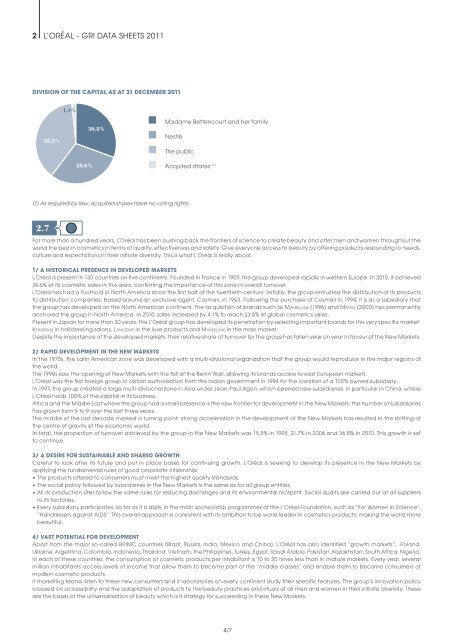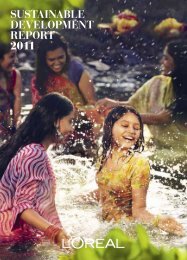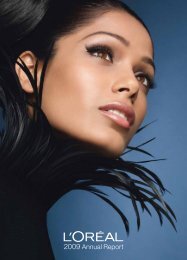Organizational Strategy - Sustainable Development - L'Oréal
Organizational Strategy - Sustainable Development - L'Oréal
Organizational Strategy - Sustainable Development - L'Oréal
Create successful ePaper yourself
Turn your PDF publications into a flip-book with our unique Google optimized e-Paper software.
2 L’OréaL - GrI DaTa SHEETS 2011<br />
DIVISION OF THE CAPITAL AS AT 31 DECEMBER 2011<br />
Madame Bettencourt and her family<br />
Nestlé<br />
The public<br />
(1) As required by law, acquired shares have no voting rights.<br />
2.7<br />
38.2%<br />
1.4%<br />
29.6%<br />
30.8%<br />
acquired shares (1)<br />
For more than a hundred years, L’Oréal has been pushing back the frontiers of science to create beauty and offer men and women throughout the<br />
world the best in cosmetics in terms of quality, effectiveness and safety. Give everyone access to beauty by offering products responding to needs,<br />
culture and expectations in their infinite diversity. This is what L’Oréal is really about.<br />
1/ A HISTORICAL PRESENCE IN DEVELOPED MARKETS<br />
L’Oréal is present in 130 countries on five continents. Founded in France in 1909, the group developed rapidly in western Europe. In 2010, it achieved<br />
39.6% of its cosmetic sales in this area, confirming the importance of this zone in overall turnover.<br />
L’Oréal has had a foothold in North america since the first half of the twentieth century. Initially, the group entrusted the distribution of its products<br />
to distribution companies, based around an exclusive agent, Cosmair, in 1953. Following the purchase of Cosmair in 1994, it is as a subsidiary that<br />
the group has developed on the North american continent. The acquisition of brands such as MaybeLLine (1996) and Matrix (2000) has permanently<br />
anchored the group in North america. In 2010, sales increased by 4.1% to reach 23.6% of global cosmetics sales.<br />
Present in Japan for more than 30 years, the L’Oréal group has developed its penetration by selecting important brands for this very specific market:<br />
Kérastase in hairdressing salons, LanCôMe in the luxe products and MaybeLLine in the mass market.<br />
Despite the importance of the developed markets, their relative share of turnover for the group has fallen year on year in favour of the New Markets.<br />
2/ RAPID DEVELOPMENT IN THE NEW MARKETS<br />
In the 1970s, the Latin american zone was developed with a multi-divisional organization that the group would reproduce in the major regions of<br />
the world.<br />
The 1990s saw the opening of New Markets with the fall of the Berlin Wall, allowing its brands access to east European markets.<br />
L’Oréal was the first foreign group to obtain authorisation from the Indian government in 1994 for the creation of a 100% owned subsidiary.<br />
In 1997, the group created a large multi-divisional zone in asia under Jean-Paul agon, which opened new subsidiaries, in particular in China, where<br />
L’Oréal holds 100% of the capital in its business.<br />
africa and the Middle East where the group had a small presence is the new frontier for development in the New Markets: the number of subsidiaries<br />
has grown from 5 to 9 over the last three years.<br />
The middle of the last decade marked a turning point: strong acceleration in the development of the New Markets has resulted in the shifting of<br />
the centre of gravity of the economic world.<br />
In total, the proportion of turnover achieved by the group in the New Markets was 15.5% in 1995, 21.7% in 2006 and 36.8% in 2010. This growth is set<br />
to continue.<br />
3/ A DESIRE FOR SUSTAINABLE AND SHARED GROWTH<br />
Careful to look after its future and put in place bases for continuing growth, L’Oréal is seeking to develop its presence in the New Markets by<br />
applying the fundamental rules of good corporate citizenship:<br />
• The products offered to consumers must meet the highest quality standards.<br />
• The social policy followed by subsidiaries in the New Markets is the same as for all group entities.<br />
• all its production sites follow the same rules for reducing discharges and its environmental footprint. Social audits are carried out at all suppliers<br />
to its factories.<br />
• Every subsidiary participates, so far as it is able, in the main sponsorship programmes of the L’Oréal Foundation, such as “For Women in Science”,<br />
“Hairdressers against aIDS”. This overall approach is consistent with its ambition to be world leader in cosmetics products: making the world more<br />
beautiful.<br />
4/ VAST POTENTIAL FOR DEVELOPMENT<br />
apart from the major so-called BrIMC countries (Brazil, russia, India, Mexico and China), L’Oréal has also identified “growth markets”: Poland,<br />
Ukraine, argentina, Colombia, Indonesia, Thailand, Vietnam, the Philippines, Turkey, Egypt, Saudi arabia, Pakistan, Kazakhstan, South africa, Nigeria.<br />
In each of these countries, the consumption of cosmetic products per inhabitant is 10 to 20 times less than in mature markets. Every year, several<br />
million inhabitants access levels of income that allow them to become part of the “middle classes” and enable them to become consumers of<br />
modern cosmetic products.<br />
It marketing teams listen to these new consumers and it laboratories on every continent study their specific features. The group’s innovation policy<br />
is based on accessibility and the adaptation of products to the beauty practices and rituals of all men and women in their infinite diversity. These<br />
are the bases of the universalisation of beauty which is it strategy for succeeding in these New Markets.<br />
4/7






